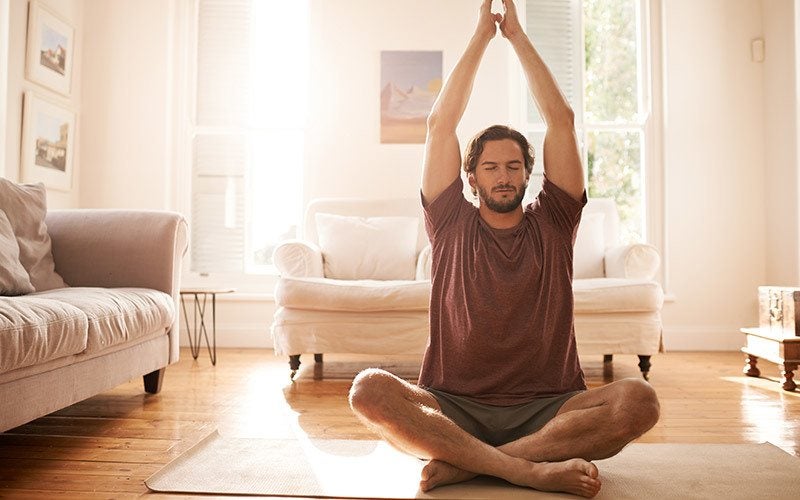Meditation: Slow yourself down! Here’s our best tips
 ©Poike
©Poike
If you’ve been feeling more stressed out than normal, consider meditation. Especially right now, it’s even harder than usual to switch your mind off and relax. And that’s why meditation is exactly what you need. Sounds counterintuitive? Give it a try. Meditating regularly can help you relax and concentrate by allowing you to become fully aware of your body and your thoughts. Let us start you off with a quick tip: Use the #poweroftogetherness by finding yourself a meditation buddy. Working together, you’ll motivate each other to stay on track.
What is meditation?
Meditation is a reflective form of relaxation. Meditation is a state of mindfulness that’s meant to help you achieve a physical and mental balance.
That sounds nice in theory but you’re probably wondering what it looks like in practice.
Imagine you’re still at work with a lot of things to do. Not to mention, all the other non-work things you have going on in the rest of your life: chores, grocery shopping, working out, picking up the kids — the list can feel endless. As a result, your mind is constantly busy dealing with several things at once. Organizing, planning, and dealing with last-minute problems is your daily routine.
But it’s important to disconnect completely at least once during the day to give your mind and body the pause from chaos that they need. Meditation can help! Relaxation isn’t as simple as sitting on the couch and watching TV. Anyone who’s marathoned something on Netflix knows that you don’t exactly feel rested when it’s all said and done. Being aware of the rest and relaxation you’re getting will actually help you get more benefits from it. And that’s where meditation comes in: It’s about taking a step back and keeping your focus on relaxation and the present moment, so that your body and especially your mind can rest. During meditation, you concentrate completely on yourself, you learn to consciously slow down your body and mind, you store up new strength, and increase your productivity.
How do you do it?
Beginners often ask themselves how to start meditating. You’re lucky, because it’s much easier than you think. As with any method of relaxation, the first step is to choose a quiet, meditative place where you can sit in peace. Turn off all forms of distractions — TV, smartphones, the works — and choose a time when you really have a few minutes to yourself.

There’s no one perfect time to meditate for everyone. Many people use meditation as a morning routine, but it’s best to try different times of the day to see which one suits you best. Before or after work, during your lunch break, on the train or in the car to work, there are plenty of moments throughout the day to squeeze in a meditation session.
The place you choose to meditate in should be quiet, clean, and comfortable. If you meditate in a room that isn’t tidy, you may feel an urge to get up and clean, even though you should be relaxing! Some people can block out the noise while meditation, but if you don’t think that you’ll be able to handle it, choose a spot where you know you’ll be fine. And if you need some guidance on cleaning your home, find yourself a guide to doing it quickly and efficiently.
You should be upright when meditating, because it’s easy to fall asleep and lose your concentration when you’re lying completely down. Choose to sit in a comfortable chair, or on the floor in the lotus or cross-legged position.
How much time you actually spend meditating isn’t that important. It’s not a competition! Even if some talented meditators can make it two hours, you don’t need to feel like you have to do the same. Five minutes of meditation a day is a good starting point for beginners. And if you don’t want to start on your own, you can easily find guided meditation online.
How to meditate: the first steps
These meditation techniques will guide you through the process of beginning your own mindfulness meditation practice.
1. Find your mantra
Start by concentrating only on your breathing in the present moment and take the time to find a mantra, so that you can recite it while you breathe and make it a driving force. Your mantra can and should be anything that makes you feel calm, centered, and focused, and you should recite it as you inhale and exhale.
2. Feel your breath
Focus on the way the air you’re inhaling feels. Is it cold or warm? What does it smell like? What do you feel when the air passes through your nostrils? And what do you feel when you slowly exhale this air?
3. Feel your body
If you can master these types of meditation, you can take the next step of mindfulness meditation. Concentrate your body. What do you feel? Do you feel heat? Do you feel cold? Do you feel pain anywhere? Try to concentrate on each part of your body separately, starting from the top of your head and working your way down to your feet — this is also known as a body scan.
4. Concentrate on your feelings
After you’ve gotten your external body to relax, focus inward. Try to determine exactly what your emotions are at that moment. Are you stressed out? Relaxed? Angry? Sad? Or anything else? Let this emotion enter you. Don’t push it away like you might during the day. Let yourself feel it entirely — even if it hurts a bit while it’s happening, you’ll almost always feel better after.
After a good meditation session, don’t immediately return to your chores. Stay in a relaxed position for a little while longer without focusing on anything special. Then slowly open your eyes again. Stretch out a little if you want to, then slowly get up again.
5. Doing it often
Meditation seems a little weird to everyone the first time they do it, but the more and more they do it the more familiar it becomes. Does meditation still seem a little weird to you? Yeah, at first it’s normal. The longer and more regularly you do it, the faster the positive effects will appear. In general, it’s better it more frequently for shorter bursts than infrequently for longer — five minutes every day, rather than an hour once a week.

The problems you might encounter
If you’ve been following our steps, meditation might seem simpler to you now. However, you may still encounter some problems that can prevent you from meditating. Here are the most common ones:
1. No time
If you think you don’t have enough time for meditation, think again! All you need is five minutes to get started. Even just this short period of meditation will help you feel rested and better able to reach your full potential. In the end, this short pause may save you time because you’ll be more productive. And honestly, if you look at your cell phone for 5 minutes less, or don’t snooze your alarm clock for 5 minutes in the morning, you’ve just saved yourself all the time you need.
Just to be double-sure you’re not using “no time” as an excuse, grab yourself a buddy for meditation motivation. Try and find a friend who’s at the same level you are — be it beginner or experienced! — so you can share your experiences, grow together, and stay on track. It actually works. Promise!
2. Too many thoughts
Incessant thinking is another common problem for those beginning their meditation practice. If you sit down to meditate only to find that thoughts keep popping up in your mind, distracting you from the process, you may feel frustrated. But it’s important to know that what you’re experiencing is normal. Accept that these thoughts can emerge, so that you can consciously put them aside and concentrate fully on your meditation. Think of your thoughts as cars passing you on the freeway — you see them, but you don’t give them your full attention.
You can also use this technique for negative attitudes such as jealousy, anger, or self-doubt. These thoughts are completely normal, and you can acknowledge them just as they are: thoughts produced by your brain that are not necessarily justified or relevant to your life.

Meditation helps you make sense of the thoughts in your head, and whether you let your thoughts determine you, or if you determine them yourself.
3. Tingling and numbness
Occasionally when you’re meditating one of your limbs may fall asleep. If this does happen to you, it can distract you from the process, but you can easily fix it by simply switching your position to a more comfortable one.
Meditation: What are the benefits?
1. You learn to relax consciously
Regular meditation can have many positive effects on you, including being able to consciously relax. You’ll be able to use this technique in any situation with a little practice — during your free time at a park, cafe, or wherever you feel good. And wherever you don’t, whether that’s on a plane, in the car, or somewhere else.
2. You increase your productivity
You learn to calm down faster, save energy for your next tasks, and you can concentrate better which can lead to an increase in productivity. Regular meditation sessions also improves concentration, and many managers use meditation to better manage their organization.
3. You have more self confidence and better stress reduction.
As your meditation practice progresses and you learn how to control your thoughts and get rid of your problems, you will gain self confidence. You will also learn to take a step back from negativity and reduce stress which will allow you to be more relaxed in everyday life.
How to meditate: Summary
- Meditation is a conscious form of relaxation.
- Repetition and regularity are important for meditation.
- It’s better to meditate five minutes a day than one hour a week.
- Meditation helps you to better control your thoughts.
- You have better resistance to stress.
- You increase your productivity.
- You have more self-confidence and are more relaxed in your daily life.
Sources for this article
We at foodspring use only high-quality sources, including peer-reviewed studies, to support the facts within our articles. Read our editorial policy to learn more about how we fact-check and keep our content accurate, reliable, and trustworthy.

































